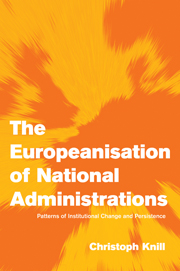Book contents
- Frontmatter
- Contents
- List of tables
- Preface
- List of abbreviations
- Introduction
- I Theoretical frame of reference and analytical approach
- II Administrative traditions in Germany and Britain: opposing patterns and dynamics
- III Domestic change and persistence: the implementation of EU environmental policy
- 6 The administrative implications of EU environmental policy
- 7 Germany: the constraints of a static core
- 8 Britain: the opportunities of a dynamic core
- IV The Europeanisation of national administrations: comparative assessment and general conclusions
- References
- Index
6 - The administrative implications of EU environmental policy
Published online by Cambridge University Press: 22 September 2009
- Frontmatter
- Contents
- List of tables
- Preface
- List of abbreviations
- Introduction
- I Theoretical frame of reference and analytical approach
- II Administrative traditions in Germany and Britain: opposing patterns and dynamics
- III Domestic change and persistence: the implementation of EU environmental policy
- 6 The administrative implications of EU environmental policy
- 7 Germany: the constraints of a static core
- 8 Britain: the opportunities of a dynamic core
- IV The Europeanisation of national administrations: comparative assessment and general conclusions
- References
- Index
Summary
The selection of EU environmental policy as an empirical case is of particular analytical advantage for the purpose of this study. On the one hand, environmental policy reflects an area where supranational policy competencies are broadly developed; there exists a comprehensive framework of European regulations confronting the member states with considerable requirements for administrative adjustment. On the other hand, comprehensiveness coincides with regulatory variety. EU environmental policy reflects no single coherent and consistent regulatory concept and approach, but reveals a regulatory patchwork of different instruments, principles and strategies. This allows for the selection of varying cases which are characterised by differing requirements with respect to administrative styles and structures.
The nature of EU environmental policy
The basic aspects characterising EU environmental policy, namely its comprehensive development as well as its considerable regulatory variety can only be understood in the light of the particular factors which shape the decision-making context at the supranational level.
Comprehensiveness and regulatory variety
From the institutional and legal perspectives, EU environmental policy differs from other policy fields such as trade, agriculture or transport primarily in that it is not explicitly mentioned in the 1957 Treaty of Rome that established the Community. This was certainly due to the lack of awareness of the issue at the time, likely to have been particularly extreme in the case of a community like the EU designed primarily to promote economic co-operation (Johnson and Corcelle 1989: 1).
- Type
- Chapter
- Information
- The Europeanisation of National AdministrationsPatterns of Institutional Change and Persistence, pp. 119 - 134Publisher: Cambridge University PressPrint publication year: 2001



